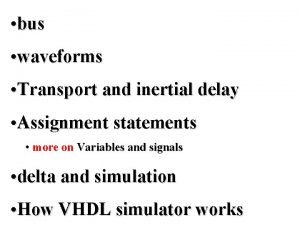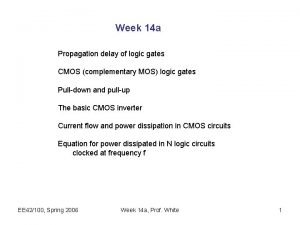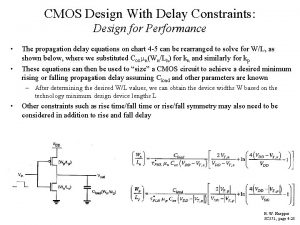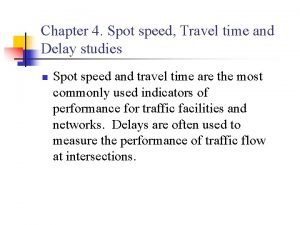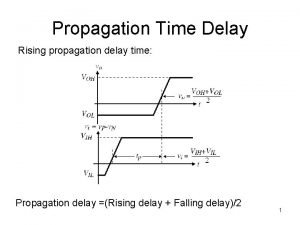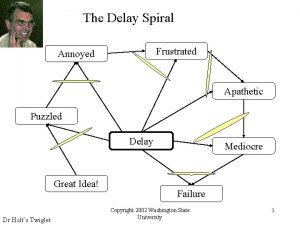Propagation Time Delay Rising propagation delay time Propagation





























- Slides: 29

Propagation Time Delay Rising propagation delay time: Propagation delay =(Rising delay + Falling delay)/2 1

Single pole response of amplifier 2

Time delay due to dynamic response 3

Slew Rate of a Comparator If the rate of rise or fall of a comparator becomes large, the dynamics may be limited by the slew rate. Slew rate comes from the relationship, i = Cdv/dt where i is the current through a capacitor and v is the voltage across it. If the current becomes limited, then the voltage rate becomes limited. Therefore for a comparator that is slew rate limited we have, tp = ∆T =∆V/SR =(VOH- VOL)/2·SR where SR = slew rate of the comparator. 4

Find the propagation delay time of an open loop comparator that has a dominant pole at 103 radians/sec, a dc gain of 104, a slew rate of 1 V/µs, and a binary output voltage swing of 1 V. Assume the applied input voltage is 10 m. V. Solution The input resolution for this comparator is 1 V/104 or 0. 1 m. V. Therefore, the 10 m. V input is 100 times larger than vin(min) giving a k of 100. Therefore, we get tp =1/103 ln(2· 100/(2· 100 -1)) = 10 -3 ln(200/199) = 5. 01µs For slew rate considerations, we get tp =1/(2· 1 x 106) = 0. 5µs Therefore, the propagation delay time for this case is the larger or 5. 01µs. 5

Two-Stage Comparator An important category of comparators are those which use a high-gain stage to drive their outputs between VOH and VOL for very small input voltage changes. The two-stage op amp without compensation is an excellent implementation of a high-gain, open-loop comparator. 6

7

8

Driving Large Capacitive Load Inverters clean up output Typically added at latch output. 9

10

11 Chapter 10 Figure 07

12

13

14

15

16

17

Input Noise on the Comparator Problem: Solution: Introduce Hysteresis 18

External Positive Feedback 19

Internal Positive Feedback 20

Chapter 10 Figure 14

Latched comparators • Pre-amplification followed by a track-and-latch. • Pre-amplification is used to obtain high resolution and to minimize “kickback” effects. • Kickback: charge transfer in or out of the input side when the track-and-latch goes from track mode to latch mode. • Pre-amplification has moderate gains, or small gains for higher speed • Output of pre-amp is small to drive digital. • It is amplified during track-and-latch modes by positive feedback which regenerates the analog signal into a full-scalar digital signal. 22

The inputs are initially applied to the outputs of the latch. Vo 1’ = initial input applied to vo 1 Vo 2’ = initial input applied to vo 2 Then positive feedback drives the higher of the two to digital 1 and the lower to digital 0 23

CMOS Latch 24

25

26

There are several comparator circuit in the book, here is one from a paper by T. B. Cho and P. R. Gray, “A 10 b, 20 Msamples/s, 35 m. W pipeline A/D Converter, ” IEEE J. Solid-State Circuits, vol. 30, no. 3, pp. 166 -172, March 1995. 27

When phi_1 is low: 28

When phi_1 is high: 29
 Propagation delay
Propagation delay Assignment statement
Assignment statement Plc timer symbol
Plc timer symbol How to calculate propagation delay in logic gates
How to calculate propagation delay in logic gates Propagation delay timing diagram
Propagation delay timing diagram Fanin and fanout in cmos
Fanin and fanout in cmos Propagation delay formula
Propagation delay formula Propagation delay formula
Propagation delay formula Ethertype 88b5
Ethertype 88b5 One way propagation delay
One way propagation delay Modified dtl gates
Modified dtl gates Seek time
Seek time How to calculate delay time
How to calculate delay time Time delay procedures
Time delay procedures Flow control valve direction
Flow control valve direction 5/2 dcv symbol
5/2 dcv symbol Shapiro time delay
Shapiro time delay You may delay, but time will not explain
You may delay, but time will not explain Double acting cylinder
Double acting cylinder Progressive time delay
Progressive time delay Overload contact symbol
Overload contact symbol Travel time and delay studies
Travel time and delay studies Elapsed time
Elapsed time Tuesday
Tuesday Linux kernel delay
Linux kernel delay Delay models in data networks
Delay models in data networks Inverter pair delay
Inverter pair delay Distributed rc delay model
Distributed rc delay model Don't delay dawns disarming display. dusk demands daylight
Don't delay dawns disarming display. dusk demands daylight Av node delay
Av node delay

